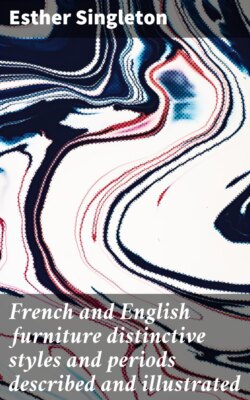Читать книгу French and English furniture distinctive styles and periods described and illustrated - Singleton Esther - Страница 4
На сайте Литреса книга снята с продажи.
PREFACE
ОглавлениеTable of Contents
PREFACE
The purpose of this work is to provide all who are interested in French and English furniture since the Renaissance period with a comprehensive and detailed view of the various periods or styles. A chapter is devoted to each period, and the chapters naturally vary in size, in accordance with the importance and length of the different periods. So far as I have been able to discover in my researches, there is no work precisely of the same aim and scope as this one in existence. Many books have been written about furniture as a whole, and the history of furniture,—especially the French styles; but I do not know of one that enables the student to learn with slight expenditure of time and energy all that is necessary to know in order to fit up a room in any given style. Anyone who wants to furnish and decorate a Louis XV. boudoir properly, or a Heppelwhite dining-room, or an Empire bedroom, can find all about it in the following pages. The collector, the student, the cabinet-maker, the upholsterer, and even the architect will find ready at hand valuable material gathered from many sources. The ceilings, wall-decorations and chimney-pieces proper to each period are described from contemporary authorities and illustrated from contemporary pictures and prints. The furniture is described from specimens existing in many collections and museums; and frequently in the words of the great makers and designers themselves.
In many instances the collector is forced to buy the survivals of whatever period he fancies, instead of being able to select for reproduction the more artistic specimens that have perished, and his rooms are filled with anachronisms because he cannot find articles to complete his set of furniture. The reproduction of a beautiful model will give more pleasure to a person of taste than a piece of furniture whose only recommendation is that it is an “antique”; and I think many persons will sympathize with me in my desire to see correct reproductions of beautiful models of furniture multiplied, as well as the textiles that accord with them.
In all periods people have given much thought not only to beautifying their homes, but to achieving the correctness of style that contributes elegance and dignity to an establishment, unconsciously following the opinion that Sir Henry Wootton gave about 1600: “Every man’s proper mansion house and home being the Theatre of his Hospitality, the seat of his self-fruition, the Comfortablest part of his own Life, the noblest of his Son’s Inheritance, a kind of Private Princedom—nay, the Possession thereof an Epitome of the whole World, may well deserve by these attributes, according to the degree of the Master, to be delightfully adorned.”
In order to give an even more thorough understanding of the appearance of the rooms, I have included many partial inventories of representative homes and many descriptions of separate sumptuous beds and other pieces of furniture typical of the style. Upholstery has received minute attention. Any one can learn here how to drape a bed, or a window; what valances, curtains, lambrequins, cords and tassels are appropriate, and what materials, braids and nails may be used.
The characteristics of the decorative art of each period are set forth with some detail, and the motives of carving of the woodwork are clearly defined in the numerous line drawings and details of the many plates.
I have carefully selected the illustrations from the designs of the recognized representatives and leaders of the styles. Besides going to these fountain-heads, I have not hesitated to adopt the views and translate in many cases the words of the recognized modern authorities on French furniture. These include Alexandre, Jacquemart, Havard, Deville, and others. In the Chippendale, Heppelwhite and Sheraton styles, these writers speak for themselves.
I wish to express my thanks to Mr. Arthur Shadwell Martin for his valuable assistance in my researches for both pictures and text.
E. S.
New York, December, 1903.
